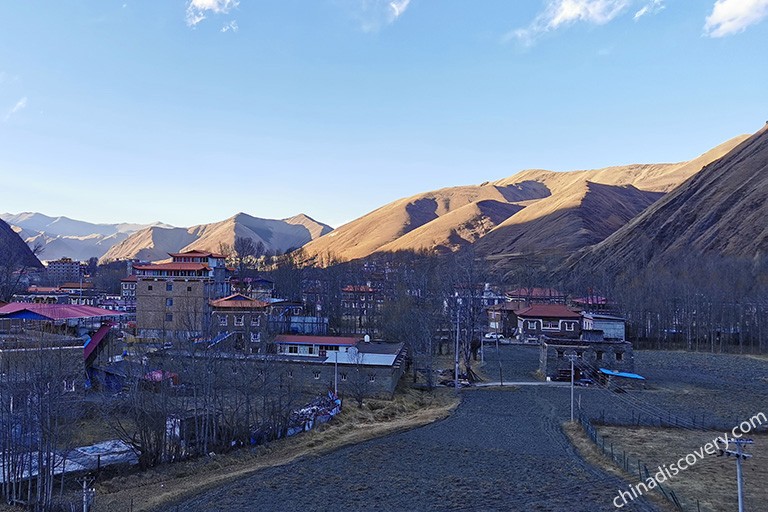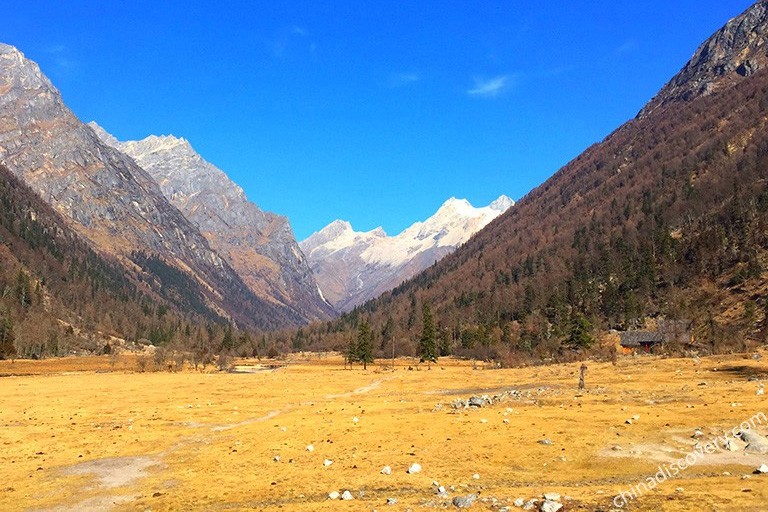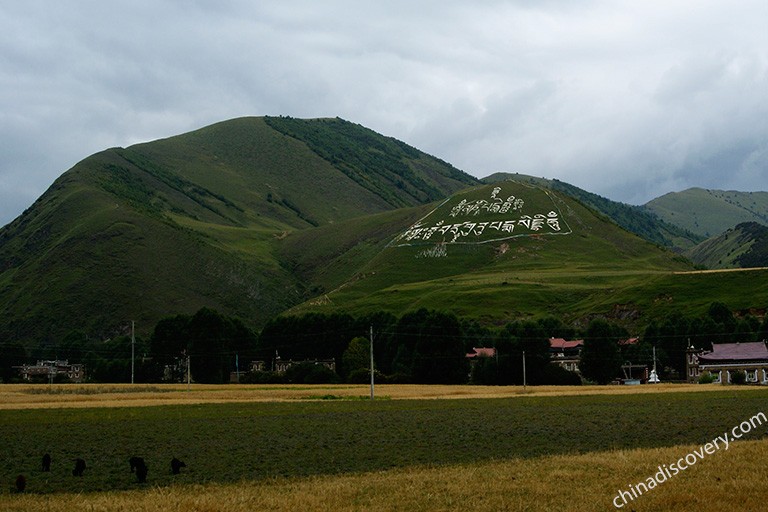Why Visit Dege Parkhang Sutra-Printing House
Dege Parkhang Sutra-Printing House or called Dege Parkhang was first built in 1729 with an area of about 1600 square meters. It maintains over 320,000 sutras plates, covering 70% of Tibet’s literary heritage, therefore, Dege Parkhang is listed as the “No.1 among the Three Great Printing Houses in Tibetan Areas” (together with those at Potala Palace and Labrang Monastery). Being praised as the Encyclopedia of Tibetan Culture, the Dazzling Cultural Pearl in Tibetan Area and the Treasury under the Snowy Mountain, Dege Parkhang Sutra-Printing House truly lives up to its reputation. It was listed in National Key Cultural Protection Unites by the State Council in 1996, and then the technique of Woodblock Printing was listed in the Represents of Human Non-material Cultural Industry by UNESCO.
What to See at Dege Parkhang Sutra-Printing House
Either in traditional Tibetan building or in bookshelf, you can easily find orderly placed woodblocks, exquisite fresco and Sutra. Well-preserved 270,000 woodblocks are the one and only in the world.
Woodblocks
Carved with both writings and paintings, the woodblocks are the major part of the cultural relics in Dege Parkhang Sutra-Printing House. Among the large quantity of writings, there are enough rare editions, only existing editions and models for calligraphy or painting. Amongst them are The History of Hindi Buddhism, The Four Medical Tantras and the last surviving copy of The History of Indian Buddhism. Though paintings are not as much as writings, they are also rather meaningful and precious. Dege is an important carrier of Men Sect and Ge Sect in traditional Tibetan. In fact, Ge Sect became a center built up in Dege. It’s a great breakthrough to integrate Tangka Art with woodblock made by Ge Sect.
Murals
Murals are scattered in the inside and outside walls of different Sutras halls, left-side and right-side of corridor as well as some walls in sutras libraries. Except for Green Tara of Men Sect, all others show a style of Ge Sect. Greatest artistic accomplishments of Ge Sect are embodied in these murals which make Dege Sutras Monastery the place with best-reserved historical murals.
Statues and Buildings
The statues in Dege Parkhang Sutra-Printing House, mainly consisting of statues of Buddha, Bodhisattva, Arhat, dharma and eminent monks and historical characters in different years, are placed in Great Sutras Library and Small Sutras Library. You can deeply feel the aesthetic tastes and consummate skills of Tibetan Buddhism from the bright color, smooth carves and vivid expressions of the statues.
Surrounded by towering red walls and lush green trees, Dege Parkhang Sutra-Printing House is quite majestic and stately. Close to the front gate is a two-story chapel, and the main hall inside has four floors. The monastery is one conventional Tibetan building with a combination of Dege monastery and Dege residence. The second and third floors are equipped with 8 libraries, printing houses and workers’ rooms while the fourth floor where enough sunshine reaches is for drying printed books.
Learning about Technological Process at Dege Parkhang Sutra-Printing House
Printing Plates Making
Raw material processing, writing and engraving are the most basic three processes. Upright and none-joint trunks of red birches are chosen as raw material. The works need to saw the trunks into planks in fixed size firstly, toast them later, and keep them in manure pit until next March or April. Then the workers take them out, boil them in water and plane them, so the planks become rough printing plates. Being checked as qualified, the plates will be sent to the monastery. Before printing, the writers will write down the sutra in paper according to the size of printing plates. The Printing workers are recruited through strict assessment, so all of them have perfect skills of Tibetan language and drawing. In order to make sure all sutras are printed with best quality, every people is limited to finish one inch of one plate in a single day.
Ink making
The ink produced and used in Dege Sutra-Printing Monastery is one smoke ink. It can be divided into two kinds while one for writing is made from Toisusu and the other for printing extracted from rind of rhododendrons. Red ink is exclusively used in print Tripitaka as a sign of respect.
Papermaking
The raw material for making paper uses the roots of Chinese Stellera Root which is a plant with flexible fiber and in good water-absorbing quality. This plant is also a slightly toxic crude drug which helps works working in dimly-lit room can see well and keep papers safety from the swallowing of moths and mice.
How to Print
The process of sutra-printing includes paper cutting, pigment processing, printing and bookbinding roughly, and more than 10 steps in details such as paper cutting, paper soaking, ink mixing, grinding, taking plate, printing, drying, washing, filing, paging, checking, bookbinding, polishing, packaging etc. . The whole process is flow and all steps are mutual intertwining in an orderly way. The ink-processing group is mainly making two kinds of ink to support printing group. Bookbinding group is in responsible for binding as well as classifying and checking. Printing bears the most heavily load and most complexed steps. Two printers sit in different altitude face to face with a plate between them. The higher worker is in charge of receiving paper, keeping the paper still and inking. The lower one pushes the batching-made roller from top to bottle as he passes the paper to the higher one in cycles. When the cleaned sutra painting is dried, they bushed over with a layer of Yak butter which makes the sutra longer. No wonder that you can smell a fragrance of Yak butter as you enter the sutra library.
Attraction around Dege Parkhang Sutra-Printing House
Gengqing Monastery is the main monastery of Sakyas of Tibetan Buddhism. It is located on the upper reached of Yalongjiang River and the Jinshajiang River, nearly 2 km away from Dege Parkhong Sutra-Printing House. There is no living Buddhist in Gengqing Monastery and it is in the charge of Tusi family. Many Buddhist activities are carried out here, you may be lucky to listen to the saint Mantra which will clean your blundering heart.
Location How to Get to Dege Parkhang Sutra-Printing House
Where is Dege Parkhong Sutra-Printing Monastery
Based in Ganzi Tibetan Autonomous Prefecture, a remote area, the transportation to Dege Parkhong Sutra-Printing Monastery is not too convenient but it is worth visiting for its amazing natural landscape and strong cultural atmosphere. The monastery is about 840 km driving distance west from Chengdu City, which needs more than 13 hours to get there from Chengdu or about 10.5 hours from Kangding City (the prefecture capital of Ganzi).
- 430 km away from Larung Gar Buddhist Academy
- 560 km away from Kangding (capital of Ganzi) downtown
- 570 km away from Daocheng Yading airport
- 840 km away from Chengdu
- No Photos in Sutras Libraries:In order to protect cultural relics, taking picture is allowed for the printing process but prohibited in sutras libraries. You can ask the workers for permission and they are always friendly.
- When to See Printing:On account of climate, the sutra-printing time ranges from 15th March to 20th September in Tibetan calendar. During this period, visitors could view and admire the operation sutras printing. And please pay attention to that printing will be ended in 16:00, and then the workers will steep and wash the woodblocks.
- Western Sichuan Small Tourist Loop
- Chengdu
- Daocheng Yading
- Mount Siguniang
- Dujiangyan
- Kangding
- Hailuogou Glacier Park
- Ya'an
- Danba
- Xinduqiao
- Tagong Grassland
- Mount Gongga
- Batang
- Jinchuan

7 Days Western Sichuan Small Loop Tour
Chengdu / Dujiangyan / Mount Siguniang / Danba / Tagong / Xinduqiao / Hailuogou / Chengdu

8 Day Diverse Sichuan Exploration Tour
Chengdu / Mount Siguniang / Danba / Tagong / Xinduqiao / Leshan / Emei / Chengdu

6 Days Western Sichuan Autumn Sightseeing Tour
Chengdu / Wolong / Mount Siguniang / Danba / Tagong / Xinduqiao / Kangding / Chengdu
- Your Question:
- Your Name:
- Your Email:
- Submit
How to Transfer to Dege Parkhang Sutra-Printing House
Travel with China Discovery (Top Recommended)If you want to get rid of hustle of public transportation and troublesome navigation, you can book a private tour package which covers sightseeing, dining and transfer from us. Our local tour guide and driver will escort you to Dege Sutra-Printing Monastery with speed and convenience, and take care of all the details. You just need to focus on sightseeing. Please feel free to tell us if you need any help!
Independent TravelMost people travel to Dege from Chengdu, and there are convenient flights and bullet trains from many other destinations in China, also many international flights. However, there is no direct bus from Chengdu to Dege. Visitors can take a bus to Kangding City first for about 4.5-8 hours and then transfer to Dege Sutra-Printing Monastery by distance bus for another 16.5 hours or hiring a local car.
Warm Tips for Visiting Dege Parkhang Sutra-Printing House
How to Plan a Dege Parkhang Sutra-Printing House Tour
You can spend 1 day to visit Dege Parkhang and other holy monasteries and cultural highlights in Dege. Besides, a lot of travelers travel Dege together with other beautiful destinations in Garze including Kangding, Luding, Xinduqiao, Tagong, Bamei, Danba, to enjoy more splendid Tibetan charm without visiting to the far Tibet, which usually takes about 6 and more days according to the destinations you choose.
Besides, you can also plan as many other visitors to travel Kangding together with Daocheng Yading to see the “Last Pure Land on Our Blue Planet” for another 1-2 days sightseeing trip!
We China Discovery based in Chengdu are experienced in tour customization! And we are very glad to help you plan your Garze tour, Chengdu tour, Sichuan tour and China tour according to your group size, interests, physical condition, time, plan, budget and every special need! Please feel free totell us if you need any help!
Recommended Sichuan Tour Packages:
>> 7 Days Sichuan Discovery Tour (Chengdu / Leshan / Emei / Chengdu / Jiuzhaigou)
>> 2 Days Classic Chengdu Tour (Hotel/Flight/Train Pickup)
>> 4 Days Daocheng Yading Hiking Tour by Flight
>> 4 Days Enjoyable Jiuzhaigou Walking Tour
Travel Dege Parkhang with China Discovery
Want to enjoy a worry-free trip to Dege Parkhang? No matter you interested in visiting Dege Parkhang Sutra-Printing House simply, or cover Dege with Kangding, Xinduqiao, Tagong, Danba, Hailuogou Glacier, Mount Siguniang in Western Sichuan or other destinations in China, China Discovery can provide you best tour guides and experienced friendly drivers with comfortable licensed private car. Our English-speaking tour guide will accompany you all the way, showing you the best traveling route and telling beautiful stories of the mysterious Sichuan. Please contact us directly to travel with us without any worry!
Keep Reading on Ganzi
Read More about West Sichuan Small Tourist Loop
Other Useful Sichuan Travel Articles
Recommended Sichuan Tours
Top 3 Sichuan tours chosen by most customers to explore Sichuan in the best way. Check the detailed itinerary, or tailor your own trip now with us.
Start planning your tailor-made holiday to China by contacting one of our specialists. Once inquired, you’ll get a response within 0.5~23.5 hours.
Customize a Trip


















































